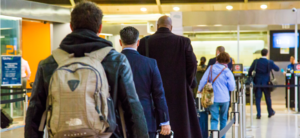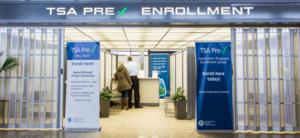As airport security lines snaked around airports like giant boa constrictors threatening to strangle passengers trying to reach their gates this spring — with waits of an hour or more in some locations, and thousands of flights missed — my wife, Catharine, and I were generally able to waltz through security in under five minutes.
In most cases, we didn’t have to take off our shoes, belts, or light jackets, and sometimes I didn’t have to remove my laptop from my briefcase. We also didn’t have to go through those infernal body scanners that require you to remove even non-metal objects from your pockets; instead, we walked through simple metal detectors.
No, we’re not airline employees, or VIPs, or anything other than ordinary travelers. We weren’t flying first class or boasting elite status with the airlines. None of our relatives work for the TSA (Transportation Security Administration).
But we did have TSA Pre√, which allowed us — again, in most cases — to enter security through a separate line that usually only had a few other passengers in it.
Many flyers, I’m sure, have heard of TSA Pre√ (or Pre-Check), but for some reason even many frequent flyers have yet to get it.
Yes, you do have to jump through a few bureaucratic hoops: filling out a form (which you can do online), scheduling an in-person appointment at an application center (bringing required documentation such as a current U.S. passport and being fingerprinted), paying a fee ($85), and undergoing a background check (which may take some time but no further effort on your part).
The only truly inconvenient part might be getting to and scheduling an appointment at a TSA Pre√ application center, often located in airports but sometimes in obscure shopping malls. There are about 400 across the country, but some like San Francisco’s are backed up for months while others take same-day appointments. So it’s good to act as quickly as possible.
I did my interview at New York’s JFK before a flight — it took only a few minutes — while Catharine did hers at Tucson International, near where we live now.
Once you’ve completed the process, you’ll wonder why you ever waited.
You then have five years of airport bliss — well, that’s going a bit too far, I admit, since not every U.S. airport honors TSA Pre√ and even some that do apply it unevenly or sporadically– but for those times when you can bypass those infuriatingly long security lines, it offers, at the very least, a sense of relief and a much better chance of making your flight Not to mention a reprieve from having to undress and redress before and after going through the body scanner.
TSA Pre√is open to “low risk” U.S. citizens, U.S. nationals and lawful permanent residents. Incomplete or false application information, various violations of transportation security regulations, and various criminal offenses all warrant disqualification.
Those who belong to various “trusted traveler” groups — including U.S. active duty military, National Guard and reserve members as well as certain government employees with security clearances — are exempt from applying.
Frequent flyers with an airline also may receive Pre√ status, but there are no guarantees of that.
Global Entry, SENTRI and NEXUS
Other “trusted traveler” programs include the U.S. Customs and Border Protection’s Global Entry, SENTRI and NEXUS.
Catharine and I actually got our TSA Pre√ clearance via the Global Entry program. Once you go through the process of being approved for Global Entry — similar to that for TSA Pre√ except that it costs $100 rather than $85 — you get TSA Pre√ as a sort of bonus.
If you travel internationally at all, it’s well worth the extra $15 to get Global Entry, which allows you to bypass the often long immigration lines at U.S. airports and instead proceed to kiosks where you scan your passport, answer a few simple customs questions, get your fingerprints tested for identification, take your receipt, and then head straight for the baggage claim.
Unfortunately, it doesn’t speed up your baggage delivery, but once you’ve collected your luggage, you can go to a fast-moving special line at Customs where you hand in your receipt and are seldom questioned further.
Along with U.S. citizens and U.S. nationals, citizens of the UK, Germany, the Netherlands, Mexico, Panama, and South Korea are also eligible for Global Entry.
Canadian citizens can enter at selected airports via the NEXUS program, which is also available to U.S. citizens whose international travel is mainly to Canada. That also requires an application, an interview, and a $50 fee.
SENTRI permits expedited entry into the U.S. via land from Mexico. An application, interview, and fee of $122. 25 are required, or, for a family with husband, wife, and minor children, a maximum total of $165.50.
Glitches in the System
For whatever reasons — cost, inconvenience of applying, or lack of publicity about the availability and benefits of TSA Pre√ and the other trusted traveler programs — enlistment goals have fallen far short of expectations: a major factor in the recent long lines at airport security stations. (Other culprits include TSA under-staffing, inefficient security procedures, and massive passenger traffic.)
Increased staffing at major airports in the U.S. that were creating the greatest bottlenecks — such as JFK, Newark, Atlanta and Los Angeles — have helped alleviate the problem, and the late-May Memorial Day crush went fairly smoothly as a result.
But that doesn’t mean the problem of long lines and frustrating delays is solved. And without TSA Pre√, you still have to take off your shoes and belt (and totally empty your pockets at airports that use body scanning machines).
I wish all U.S. airports honored TSA Pre√ and applied it consistently, but when it works, it makes the flying experience less miserable and more tolerable.
And in the current state of aviation, that’s about as much as you can ask for.















2 Responses to Avoid Long Airport Lines With TSA Pre√